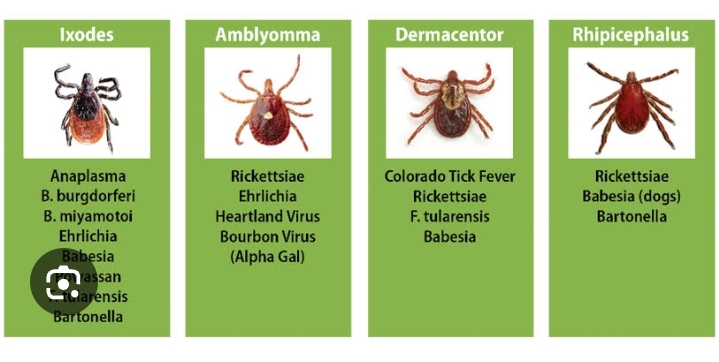
Tick fever infections are caused by various pathogens transmitted through tick bites, leading to different diseases depending on the specific pathogen. Some common tick-borne diseases include Lyme disease, Rocky Mountain spotted fever, tick-borne encephalitis, Ehrlichiosis, Anaplasmosis, and Babesiosis.

Causes of Tick Fever Infections
- Causes of Tick Fever Infections
- Symptoms of Tick Fever Infections
- Diseases Caused by Tick Fever Infections
- Treatment of Tick Fever Infections
- Prevention
- 1. Health Impacts
- 2. Economic Impacts
- 3. Behavioral Changes
- 4. Impact on Breeding Programs
- 5. Transmission of Disease
- 6. Impact on Wildlife
- 1. Lyme Disease
- 2. Rocky Mountain Spotted Fever (RMSF)
- 3. Anaplasmosis
- 4. Ehrlichiosis
- 5. Babesiosis
- 6. Tick-Borne Encephalitis (TBE)
- 7. Tularemia
- 8. Crimean-Congo Hemorrhagic Fever (CCHF)
- 9. Southern Tick-Associated Rash Illness (STARI)
- 10. Powassan Virus Disease
- 11. Tick Paralysis
- 12. Heartland Virus Disease
- 13. Relapsing Fever
- 14. Bartonellosis
- 15. Q Fever
Tick fever infections are caused by bacteria, viruses, or parasites transmitted when an infected tick bites a human or animal. The tick becomes infected by feeding on the blood of an infected host (such as a bird or rodent) and then passes the pathogen to the next host it feeds on.
Symptoms of Tick Fever Infections
Symptoms vary depending on the specific disease but commonly include:
- Fever
- Headache
- Fatigue
- Muscle and joint aches
- Rash (which can differ in appearance)
- Chills
- Swollen lymph nodes
- Nausea and vomiting
- Neurological symptoms (in severe cases)
Diseases Caused by Tick Fever Infections
Some of the diseases caused by tick-borne pathogens include:
- Lyme disease: Caused by Borrelia burgdorferi bacteria.
- Rocky Mountain spotted fever (RMSF): Caused by Rickettsia rickettsii bacteria.
- Tick-borne encephalitis (TBE): Caused by the tick-borne encephalitis virus.
- Ehrlichiosis: Caused by Ehrlichia bacteria.
- Anaplasmosis: Caused by Anaplasma phagocytophilum bacteria.
- Babesiosis: Caused by Babesia parasites.
- Also Read about Bovine tuberculosis
Treatment of Tick Fever Infections
Treatment varies based on the specific disease:
- Antibiotics: Used for bacterial infections like Lyme disease and RMSF. Early treatment is crucial.
- Antiviral Medications: Sometimes used for viral infections like TBE.
- Symptomatic Treatment: Pain relievers and anti-inflammatory medications may be used to manage symptoms.
- Hospitalization: May be necessary for severe cases.
- Supportive Care: Includes hydration, rest, and monitoring.

Prevention
Preventing tick bites is key to avoiding tick fever infections. This includes using insect repellents, wearing protective clothing, and regularly checking for ticks after spending time in areas where ticks are common.
Impacts Of Tick Fever diseases
Tick fever can have significant impacts on animals, particularly livestock and pets. The severity of the impact depends on the type of tick-borne disease, the animal species, and the overall health of the animal. Here are some of the main effects:
1. Health Impacts
- Anemia: Ticks feed on the blood of their hosts, which can lead to significant blood loss, especially in severe infestations. This can cause anemia, weakness, and fatigue in animals.
- Fever and Lethargy: Many tick-borne diseases cause fever, lethargy, and general malaise, making the animal weak and less active.
- Organ Damage: Some tick-borne diseases, such as babesiosis and anaplasmosis, can lead to severe organ damage, particularly affecting the liver, kidneys, and spleen.
- Neurological Symptoms: Diseases like tick paralysis, caused by toxins in tick saliva, can lead to neurological symptoms, including paralysis, which can be fatal if it affects the respiratory muscles.
- Reproductive Issues: In livestock, tick fever can lead to reproductive issues, including abortion in pregnant animals, reduced fertility, and weakened offspring.
2. Economic Impacts
- Reduced Productivity: In livestock, tick fever can lead to decreased milk production, weight loss, and poor growth rates, which can significantly affect the profitability of farming operations.
- Treatment Costs: The cost of veterinary care, including the use of medications, tick control measures, and supportive care, can be substantial.
- Loss of Animals: Severe tick infestations and untreated tick-borne diseases can lead to the death of animals, resulting in significant financial losses.
3. Behavioral Changes
- Irritability: Ticks can cause significant discomfort, leading to irritability and restlessness in animals. In severe cases, animals may injure themselves while trying to remove ticks.
- Decreased Appetite: Due to the discomfort and systemic illness caused by tick fever, animals often lose their appetite, leading to further weakness and weight loss.
4. Impact on Breeding Programs
- Genetic Losses: In valuable breeding stock, the loss of animals due to tick fever can lead to significant setbacks in breeding programs, including the loss of desirable genetic traits.
5. Transmission of Disease
- Zoonotic Potential: Some tick-borne diseases can be transmitted from animals to humans, posing a risk to pet owners, livestock handlers, and veterinarians. For example, Lyme disease and Rocky Mountain spotted fever can affect both animals and humans.
6. Impact on Wildlife
- Biodiversity Loss: In wildlife populations, tick fever can contribute to the decline of certain species, particularly if they are already stressed by other environmental factors. This can have broader ecological impacts by disrupting food chains and ecosystems.
Overall, tick fever can have profound and wide-ranging effects on animal health, welfare, and productivity, making it a significant concern in both domestic and wild animal populations. Preventive measures, such as tick control and vaccination (where available), are essential to mitigate these impacts.
Diseases that can be Caused by Ticks:
Ticks are vectors for several diseases that can affect both humans and animals. These diseases are caused by bacteria, viruses, and parasites transmitted through tick bites. The specific diseases vary depending on the geographic region and the species of tick. Here’s an overview of some of the most common tick-borne diseases:

1. Lyme Disease
- Causative Agent: Borrelia burgdorferi (bacteria)
- Tick Vector: Black-legged tick (Ixodes scapularis) in the U.S. and sheep tick (Ixodes ricinus) in Europe.
- Symptoms: Fever, headache, fatigue, and a characteristic “bull’s-eye” rash called erythema migrans. If untreated, it can lead to joint pain, neurological problems, and heart issues.
2. Rocky Mountain Spotted Fever (RMSF)
- Causative Agent: Rickettsia rickettsii (bacteria)
- Tick Vector: American dog tick (Dermacentor variabilis), Rocky Mountain wood tick (Dermacentor andersoni), and brown dog tick (Rhipicephalus sanguineus).
- Symptoms: Fever, headache, rash, and muscle pain. RMSF can be severe and potentially fatal if not treated early.
3. Anaplasmosis
- Causative Agent: Anaplasma phagocytophilum (bacteria)
- Tick Vector: Black-legged tick (Ixodes scapularis) and Western black-legged tick (Ixodes pacificus).
- Symptoms: Fever, headache, muscle pain, and chills. It can cause severe illness in some individuals.
4. Ehrlichiosis
- Causative Agents: Ehrlichia chaffeensis and Ehrlichia ewingii (bacteria)
- Tick Vector: Lone star tick (Amblyomma americanum).
- Symptoms: Fever, chills, headache, muscle aches, and sometimes a rash. It can lead to serious complications if untreated.
5. Babesiosis
- Causative Agents: Babesia microti and other Babesia species (parasites)
- Tick Vector: Black-legged tick (Ixodes scapularis).
- Symptoms: Fever, chills, sweats, headache, body aches, and hemolytic anemia. Severe cases may occur in individuals with weakened immune systems.
6. Tick-Borne Encephalitis (TBE)
- Causative Agent: Tick-borne encephalitis virus (TBEV)
- Tick Vector: Ixodes ricinus in Europe and Ixodes persulcatus in Asia.
- Symptoms: Fever, headache, and neurological symptoms such as confusion, seizures, and paralysis. TBE can be severe and may lead to long-term neurological damage.
7. Tularemia
- Causative Agent: Francisella tularensis (bacteria)
- Tick Vector: Dog tick (Dermacentor variabilis), wood tick (Dermacentor andersoni), and lone star tick (Amblyomma americanum).
- Symptoms: Fever, skin ulcers, swollen lymph nodes, and respiratory issues. Tularemia can be life-threatening without prompt treatment.
8. Crimean-Congo Hemorrhagic Fever (CCHF)
- Causative Agent: Crimean-Congo hemorrhagic fever virus (CCHFV)
- Tick Vector: Hyalomma species.
- Symptoms: High fever, muscle pain, dizziness, neck pain, and vomiting. Severe cases can cause hemorrhaging and organ failure.
9. Southern Tick-Associated Rash Illness (STARI)
- Causative Agent: Possibly Borrelia lonestari (bacteria)
- Tick Vector: Lone star tick (Amblyomma americanum).
- Symptoms: Similar to Lyme disease, with a rash and flu-like symptoms, but generally less severe.
10. Powassan Virus Disease
- Causative Agent: Powassan virus
- Tick Vector: Black-legged tick (Ixodes scapularis) and groundhog tick (Ixodes cookei).
- Symptoms: Fever, headache, vomiting, weakness, and neurological symptoms. It can lead to encephalitis or meningitis and may be fatal.
11. Tick Paralysis
- Causative Agent: Neurotoxin in tick saliva
- Tick Vector: Various species, including the American dog tick (Dermacentor variabilis) and Rocky Mountain wood tick (Dermacentor andersoni).
- Symptoms: Progressive paralysis starting in the lower extremities and ascending to the upper body. It can be fatal if it affects the respiratory muscles, but removing the tick usually results in rapid recovery.
12. Heartland Virus Disease
- Causative Agent: Heartland virus
- Tick Vector: Lone star tick (Amblyomma americanum).
- Symptoms: Fever, fatigue, headaches, muscle aches, and diarrhea. Some cases can be severe.

13. Relapsing Fever
- Causative Agent: Borrelia species (different from Lyme disease)
- Tick Vector: Soft ticks (Ornithodoros species).
- Symptoms: Recurring episodes of fever, headache, muscle and joint aches, and nausea.
14. Bartonellosis
- Causative Agent: Bartonella species (bacteria)
- Tick Vector: Various species, though the exact role of ticks in transmission is still under study.
- Symptoms: Fever, headache, fatigue, and, in severe cases, endocarditis and other systemic infections.
15. Q Fever
- Causative Agent: Coxiella burnetii (bacteria)
- Tick Vector: Various species, though ticks are less commonly the primary mode of transmission (usually occurs via inhalation of contaminated particles).
- Symptoms: High fever, chills, muscle pain, severe headache, and, in chronic cases, endocarditis.
These are some of the most well-known tick-borne diseases, but there are others as well, depending on the region and the tick species involved. Prevention through tick control and prompt removal of ticks is crucial in reducing the risk of these infections.

Leave a Reply